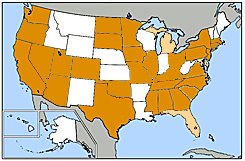San Francisco, CA

Okay, it’s time to rant about airline safety presentations. They’re pretty lame. Perhaps as a teacher I’m a little sensitive about how information is presented, but judging by faces of the passengers around me, I’m not the only one.
There are federal guidelines (standards) that specify what must be presented, but airlines all do it a little bit differently. A little. Most big planes are now graced with video screens where a nicely produced feature pleasantly welcomes us and smiley, attractive people instruct us what to do if we land in water, don’t understand modern seat belt technology, or gasp for breath due to the loss of cabin pressure. (The little girl today looked strangely calm while she waited for her mom to affix her own mask before helping her daughter. Perhaps oxygen wasn’t reaching her brain.) Attractive attendants, Gershwin in the background… they’re pretty slick productions. They must take some of the monotony out of the job for the actual flight attendants.
But the question should probably be asked: Do they work? Does the cinema version work better than the live theater version? Are we really prepared? My guess is that we’re probably not, and any of us that are prepared for disaster are only prepared because it’s been drilled into us over dozens of flights. This is just my guess, which is probably about as good as anyone’s. No one assesses what we need to know (except for the brief walk-by check of our seat belts. How can they see those so quickly? They’re like my mom! Superhuman sensory perception!) Have you ever been tested to see if you knew how to use the floating seat cushions or the inflatable life vests? (I was on a flight recently where they said "most seat cushions can be used as a floatation device." Most?!? I hope I paid for one of those seats!)
And perhaps just as important for the average, non-disaster flight: do we feel welcome and valued? Not yet. At least not until I’ve got an ice-cold cranberry juice sitting on my tray table (which is currently in the “upright and locked position,” a phrase that flows from the mouth of a traveler like the word “elemenopee” flows from a young child.)
So where is the performance assessment? Where is the support for the Japanese-speaking family sitting a few rows in front of me? Where is the relevance? Where is the community? Where is the love?
(Gee, I wonder where I’m going with this.)
Do our students board a 10-month long flight each fall, ready to be bored and isolated? Do we present a sterile smattering of facts and skills that “you might use someday” to the masses, unsure if they are listening or learning? Will teachers someday be replaced by video presentations?
I flew Southwest airlines about a decade ago to a friend’s wedding and still remember the flight. Why? Here’s a sample: “There are two designated smoking areas on the airplane tonight, one located on each wing…” or “In the unlikely event of a loss of cabin pressure, affix your own oxygen mask, then assist your children, starting with the one you like the most…” Classic! By the end of the flight, my friends and I were assisting with the snacks, collecting garbage, and even got to make the arrival announcement on the PA. Where’s the love? Right there.
So why was it so good? Why do I remember? Because it was a perfect balance. A stand-up comedy routine might be funny, but generally contains little useful information. A safety presentation contains plenty of information, but very little of it will be remembered. The balance is the key, and I think we’re out of balance. We are so focused on getting information into kids’ heads that we forget that the same heads need to smile! Learning is fun, and schools ought to be demonstrating that to kids, not turning them off to it.
So we laugh often in our science classroom, and don’t take ourselves too seriously. It helps kids learn, but more importantly it reminds me that we are all human, and that we are all equal.


















